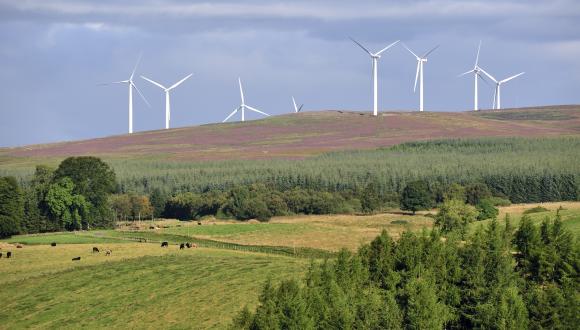Wind farm impacts on birds - Use of Avoidance Rates in the NatureScot Wind Farm Collision Risk Model
This document is intended for anyone involved with collision risk modelling for birds at onshore wind farms (e.g. developers and their ecological consultants, NatureScot staff and those within consenting authorities).
1. Purpose
The potential for birds to collide with turbines is one of the main impacts to consider in the development of a wind farm. The NatureScot Collision Risk Model (CRM) (also known as the Band model (Band et al., 2007; SNH, 2000)) provides a method based on vantage point data to estimate the number of birds likely to collide with turbines at a proposed wind farm. This allows pre-construction assessment of collision impacts on local and national populations. As birds may avoid a wind farm (for example some may be displaced from the area, while others may avoid turbines or take other evasive action to prevent a collision), the CRM accounts for this by applying an avoidance rate.
This guidance provides recommended avoidance rates for a number of key species for use in the NatureScot Collision Risk Model. This document is intended for anyone involved with collision risk modelling for birds at onshore wind farms (e.g. developers and their ecological consultants, NatureScot staff and those within consenting authorities). It is updated when robust new information becomes available. This document replaces previous 2010 and 2016 versions and includes an update for red kite.
2. Recommended avoidance rates
Table 1 presents the current recommended avoidance rates for key species, with links to supporting evidence for these. For species not listed in Table 1, we recommend a default value of 98%.
| Species | Recommended avoidance rate | Rationale/supporting evidence |
|---|---|---|
| Red-throated diver | 99.5% | Furness (2015) |
| Black-throated diver | 99.5% | Breeding birds show similar behaviour to red-throated diver; Furness (2015) |
| Swans (all species) | 99.5% | Increased from previous rate of 98% based on evidence presented in Whitfield & Urquhart (2015), but slightly more precautionary than report recommendation given this was based on a short run of data from one study |
| Geese (all species) | 99.8% | SNH (2013) |
| Red kite | 99% | Urquhart & Whitfield (2016) |
| Hen harrier | 99% | Whitfield & Madders (2006a) |
| Golden eagle | 99% | Whitfield (2009) |
| White-tailed eagle | 95% | Sufficient evidence from flight behaviour and collision monitoring studies in Norway for vulnerability to collisions; see May et al. (2011) |
| Kestrel | 95% | Sufficient evidence from flight behaviour (including hovering) and collision monitoring studies for vulnerability to collisions; see Whitfield & Madders (2006b) |
| Great skua | 99.5% | Furness (2015) |
| Arctic skua | 99.5% | Similar behaviour of breeding birds to great skua; Furness (2015) |
3. Contact:
If you have any comments or queries about this guidance, please contact Dr Jessica Shaw at the NatureScot office at Stilligarry, South Uist, HS8 5RS, or email: [email protected]
4. References
SNH (2013) Avoidance rates for wintering species of geese in Scotland at onshore wind farms. SNH Guidance Note
Whitfield, D.P. (2009) Collision avoidance of golden eagles at wind farms under the ‘Band’ collision risk model. Report to SNH.
Whitfield, D.P. & Madders, M. (2006a) A review of the impacts of wind farms on hen harriers Circus cyaneus and an estimation of collision avoidance rates. Natural Research Information Note 1 (revised). Natural Research Ltd, Banchory, UK.
Whitfield, D.P. & Madders, M. (2006b) Deriving collision avoidance rates for red kites Milvus milvus. Natural Research Information Note 3. Natural Research Ltd, Banchory, UK.
Whitfield, D.P. & Urquhart, B. (2015) Deriving an avoidance rate for swans suitable for onshore wind farm collision risk modelling. Natural Research Information Note 6. Natural Research Ltd, Banchory, UK.
Published: Sept 2018 v2
Accessibility: This pdf is not accessible
Document downloads
Disclaimer: Scottish Natural Heritage (SNH) has changed its name to NatureScot as of the 24th August 2020.
At the time of publishing, this document may still refer to Scottish Natural Heritage (SNH) and include the original branding. It may also contain broken links to the old domain.
If you have any issues accessing this document please contact us via our feedback form.




